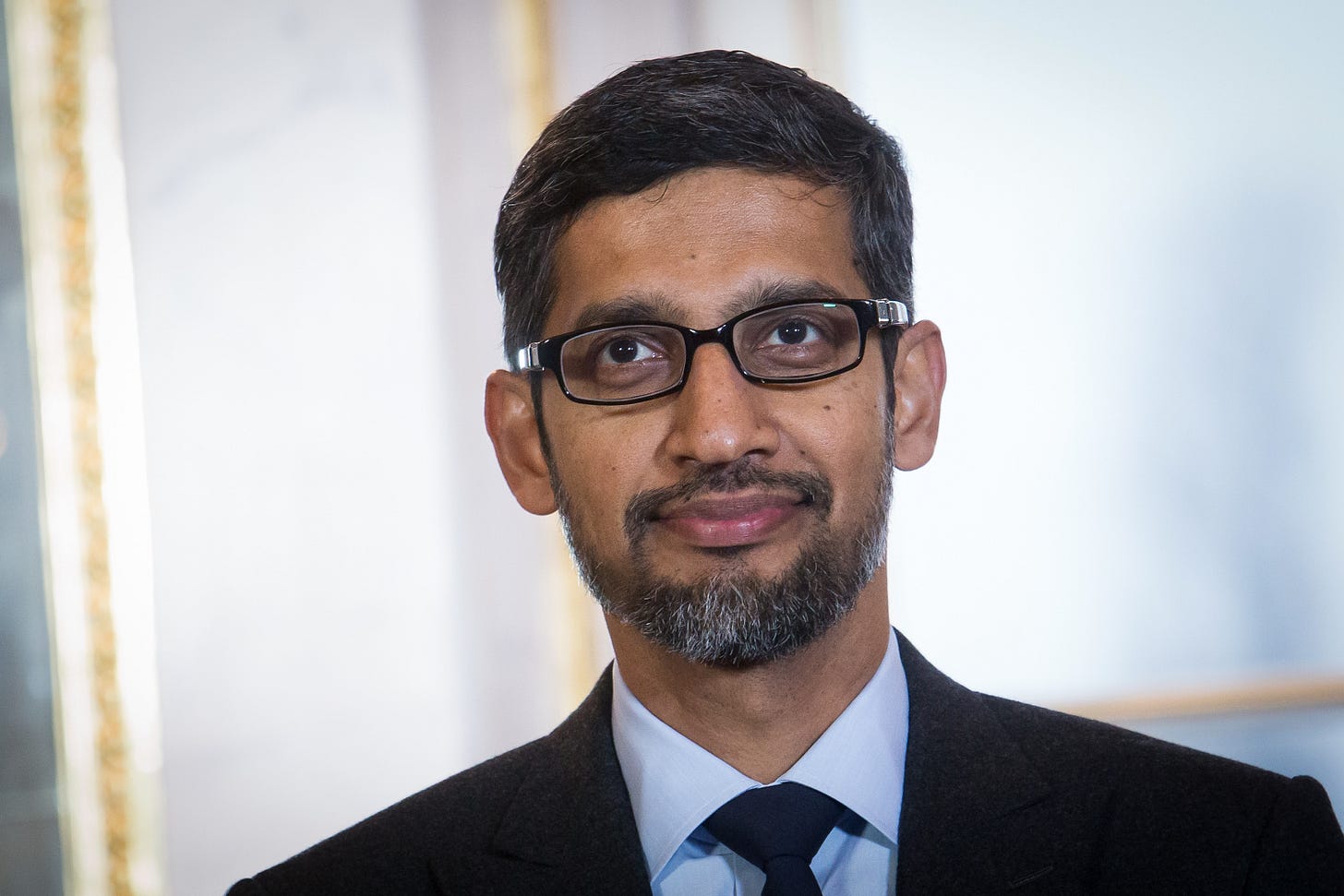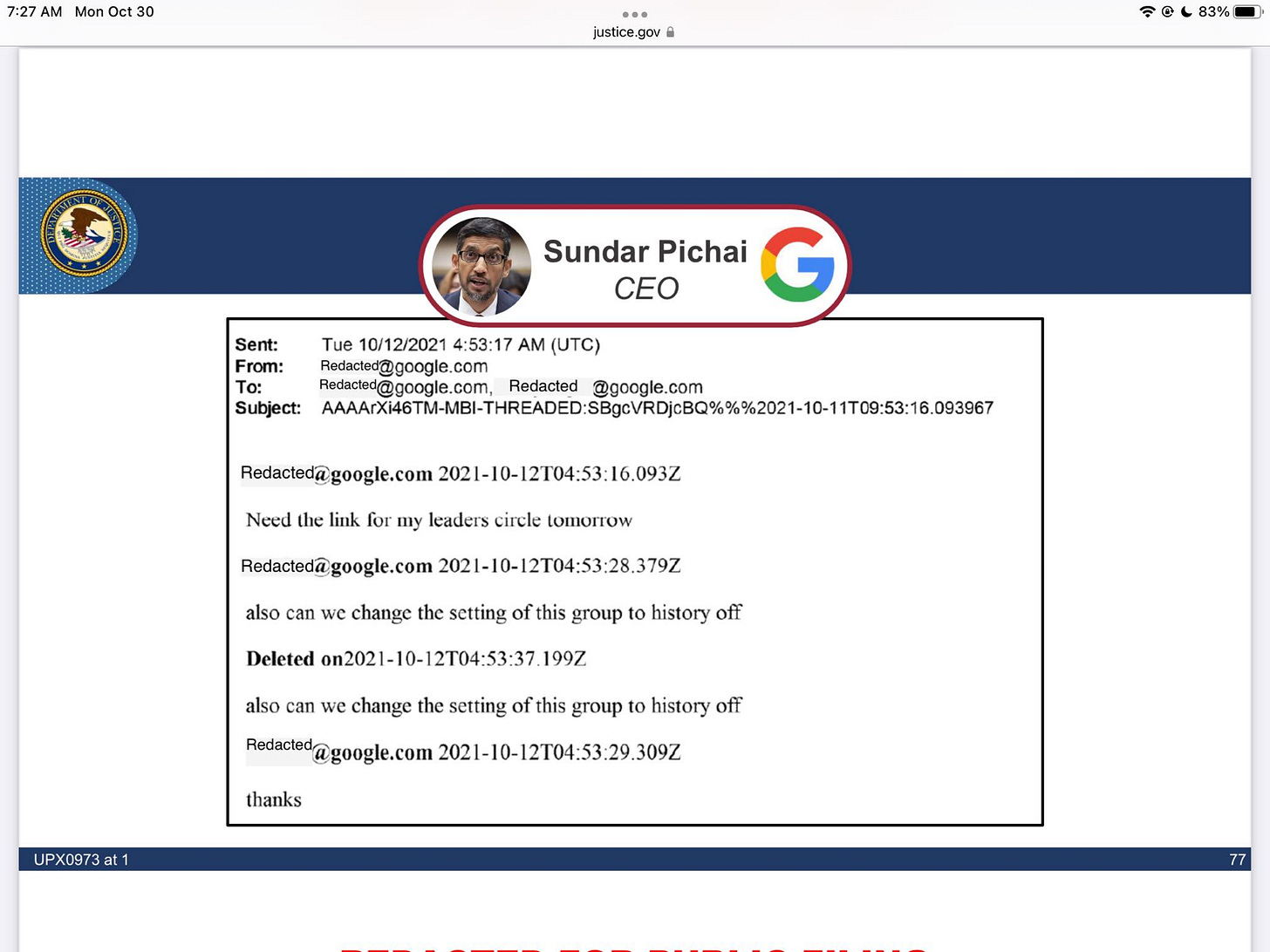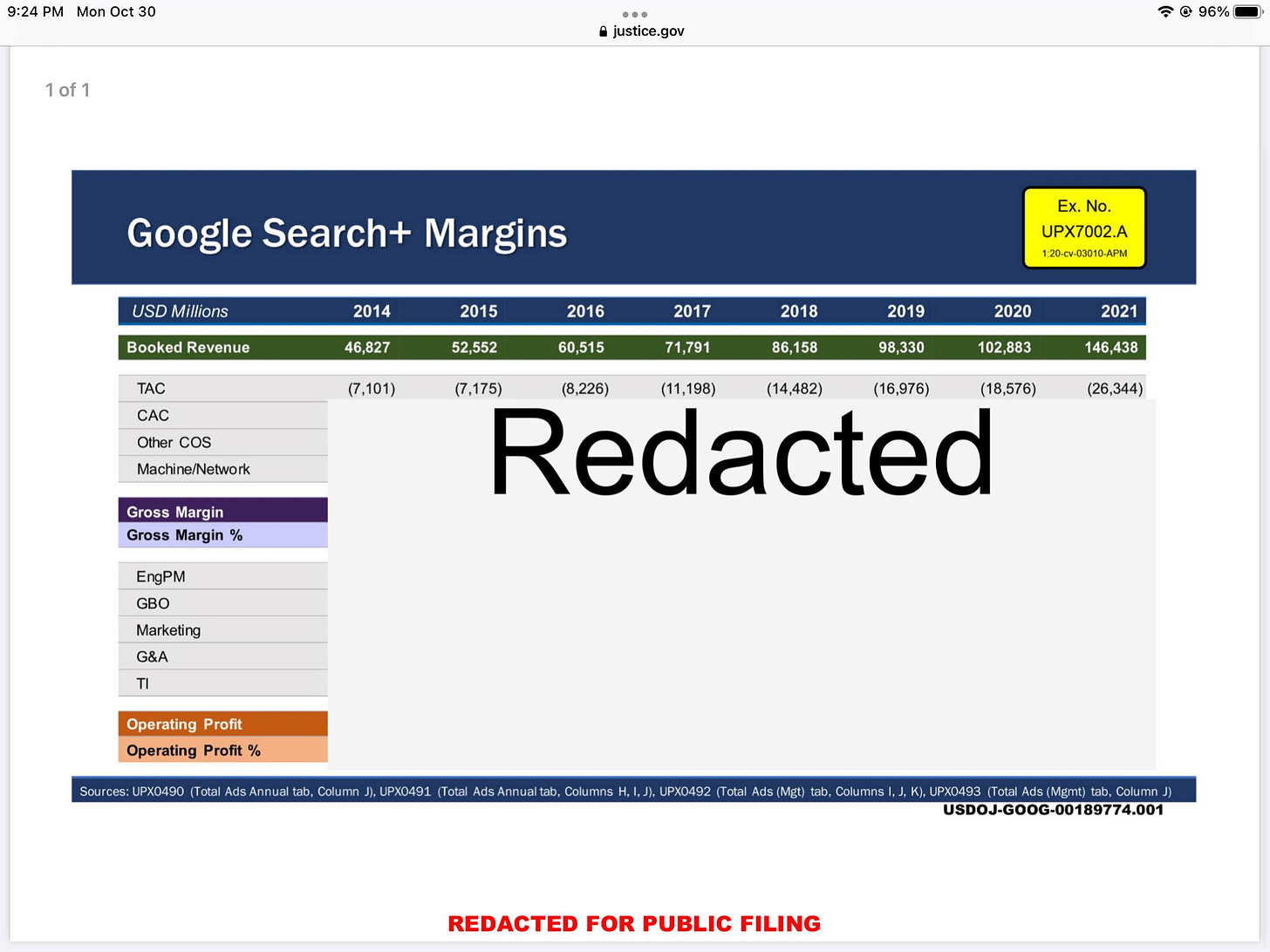DOJ puts Sundar Pichai in the crosshairs
Day 29-30: Despite resting its case more than a week ago, DOJ continues to offer new evidence through aggressive cross-examinations.
On Day 30 of the trial, we finally got to hear from the “star witness” of Google’s defense: Google/Alphabet CEO Sundar Pichai.

Although Pichai’s name has come up multiple times throughout the trial, there was a question of whether we would learn anything new from his testimony on the eighth week of the trial. Before Pichai took the stand this morning, one former chief economist for the DOJ’s Antitrust Division speculated that Pichai’s testimony on Day 30 of the trial would “largely [be] an element of theater….I don’t think there will be any blockbuster revelations.”
That was largely true for the roughly 45 minutes Google spent on its direct examination with Pichai. After asking Pichai about his upbringing in India and path to Google — through Stanford, Wharton, and McKinsey — Google’s questions about Pichai’s time at Google stayed pretty surface-level.
Pichai highlighted Google’s mission of improving access to the world’s information and contributed to Google’s core defense that innovation makes Google great by highlighting some of Google’s achievements he was proud of. He was also asked why Google pays for defaults if users can switch them — he said “we want to make it seamlessly easy for users to access our services” — but none of his testimony on direct waded into particularly new territory.
It turned out that DOJ had other plans for its cross-examination of Pichai, though.
Much of DOJ’s questioning of Pichai on cross focused on a never-before-seen letter that Google’s then-chief lawyer David Drummond sent to his counterpart at Microsoft in 2005 when Microsoft was testing a new version of its browser: Internet Explorer 7. The letter accused Microsoft of engaging in behavior very similar to the conduct that Google is currently on trial for.
It will probably take a day or two for the letter to be released to the press and public, but I did my best to write down some of the key excerpts from it while it was displayed in court. Here’s part of what Google had to say to Microsoft about Internet Explorer 7:
(10/31 update: Here’s the link to the letter Google sent to Microsoft, which the DOJ posted overnight: https://www.justice.gov/d9/2023-10/417451_0.pdf).
“We are deeply concerned about the potential for harm to the competitive process from Microsoft’s actions, particularly given Microsoft’s monopoly position with its Windows OS and its Internet Explorer browser.”
“By pushing out an update of Internet Explorer with a new search box that will default to Microsoft’s own search product in the vast majority of cases, Microsoft would gain a large number of search users for reasons having nothing to do with the merits of Microsoft’s search offering.”
The letter also mentioned Google’s proposal to Microsoft that it should instead prompt users to select a default search provider the first time they use the in-line search feature.
Google will argue that there are important differences between its default deals now and Microsoft’s use of defaults in Internet Explorer back then. For example, Google has tried to make the point that it is much easier to switch a default away from Google on Safari than it is to switch when Microsoft sets the default. But it’s hard to deny the parallels — and despite the passage of time since the letter, Judge Mehta may well read this letter to undermine Google’s defense.
Another segment of DOJ’s direct examination focused in on Google’s relationship with Apple, particularly a 2018 meeting that Pichai and other Google executives had with Apple CEO Tim Cook about the deceleration of growth Apple was seeing in its revenue share payments from Google. An internal recap of the meeting sent by Google executive Donald Harrison emphasized the close relationship the two companies attempted to foster through their search default deals, which the New York Times recently reported was worth $18 billion in 2021.
Here’s what I was able to write down from the recap Harrison sent to other Google executives:
“Tim [Cook]’s overall message to Google was ‘I imagine us as being able to be deep deep partners’; deeply connected where our services end and yours begin….[Tim] wants to figure out how we work more deeply together (and share information better — he stressed this a few times).”
“Sundar also strongly stated that you send us queries and we do our best to answer these (and monetize) - always in good faith and because our incentives are aligned - please trust this.”
Pichai denied that he ever had a vision that Google and Apple should work together as if “we are one company” and emphasized the various ways in which Google and Apple compete through their internet browsers, mobile operating systems, and more. He said there have been frequent tensions between the companies, and attributed the tone of this meeting to “irrational exuberance” about working together on search distribution towards their mutual benefit.
Google’s history-off chats
The DOJ concluded its direct examination with 20+ minutes of questions regarding Google’s chat retention policies, which are the subject of DOJ’s pending motion for sanctions against Google. We learned that Google’s policy of setting the default of internal Google chats to history-off dates back to 2008, and was at least partially motivated by increasing litigation and regulatory risk such as the DOJ’s review of Google’s proposed deal with Yahoo!.
The company-wide email that announced the policy change in 2008 included an instruction for employees subject to a litigation hold: “If you’ve received notice that you’re subject to a litigation hold, and you must chat regarding matters covered by that hold, please make sure those chats are ‘on the record.’”
It is unclear what kind of additional instructions Google employees may have received about their preservation obligations, but we’ve heard multiple Google employees throughout the trial acknowledge that they used history-off chats despite being put on a litigation hold.
Pichai for his part distanced himself from this policy, saying that it wasn’t brought to his attention as something that should be changed when he became CEO. He also maintained that he understood he was under a litigation hold in 2021 and was not discussing anything at all related to the litigation when he asked — and then quickly deleted the message — for a group chat’s setting to be switched to history-off. He explained that the “leaders circle” was referring to a public speaking event about Google Cloud, not some internal group of executives within Google.
During this exchange about Google’s chat-retention practices, DOJ also highlighted one more portion of the 2005 letter Google sent to Microsoft: “Finally, although Google hopes that legal action will not be necessary, we recognize that it is a foreseeable possibility. Accordingly, Google requests that Microsoft take care to retain all past and future records relating to any plans to tie search to any Microsoft product or otherwise deprive consumers of a competitive choice in search.”
DOJ still building its case
DOJ and the States have officially rested, but the last couple of days of trial have made clear that both plaintiffs are still building their cases against Google.
Just as DOJ introduced previously undisclosed documents while examining Pichai today, we learned several new facts during DOJ’s continued questioning of Google SVP Prabhakar Raghavan on Friday.
The biggest revelation from Friday? In 2021, Google paid a total of $26.3 billion to search distribution partners like Apple, Samsung, and other mobile carriers/device makers. We didn’t learn how this $26 billion was broken up between different partners, but the New York Times’ report that roughly $18 billion of it went to Apple helps to paint a fuller picture.1 Here’s the exhibit breaking down Google Search+’s booked revenue and traffic acquisition costs — which refers to Google’s defaults deals — from 2014 to 2021.
A lot of relevant numbers remain redacted, but DOJ also elicited from Raghavan the fact that the $26.3 billion Google shared with partners in return for default search engine status was more than the amount Google spent on R&D for Google search.
Judge Mehta also ruled against Google’s request to maintain the confidentiality of a list of its 20 highest-revenue search query terms for a week in 2018. It’s unclear how much the list supports the DOJ’s case, but it provides some insider insight into the search terms that make Google the most money with advertisers.
The actual revenue amounts were redacted but here was the order of the top 15 queries: 1) iphone 8; 2) iphone 8 plus; 3) auto insurance; 4) car insurance; 5) cheap flights; 6) car insurance quote; 7) direct tv; 8) online colleges; 9) at&t; 10) hulu; 11) iphone; 12) uber; 13) spectrum; 14) comcast; 15) xfinity.
Additional trial updates
The courtroom cleared out significantly after Pichai finished his testimony this afternoon, but the trial carried on with testimony from Virginia Tech computer science professor Edward Fox.
Fox’s testimony was technical — frankly, a good amount of it went over my head — but his primary conclusion after conducting a "data reduction experiment” (DRE) was that “the vast majority of the Google-Microsoft search quality gap must be explained by factors other than the volume of user interaction data.”
More specifically, his study found that only 2.9% of the gap between Google and Bing could be explained by user-interaction data. For longtail queries, 3.4% of the quality cap could be explained by user data. While Fox said he didn’t study what accounts for the remaining 97% of the quality gap, Fox’s testimony supported Google’s argument that scale does not explain Google’s success.
This prompted an interesting question from Judge Mehta that DOJ picked up on its cross-examination: if user data is of such limited value to Google, then why does Google pay to store so much of it?
We didn’t get a clear answer from Fox on this — it sounds like it was outside the scope of what he studied — but he will re-take the stand for additional cross-examination tomorrow.
Finally: last week, Judge Mehta ruled on the the New York Times’ motion to intervene, which places new obligations on all of the parties to make their admitted exhibits publicly available. This new process involves a “designated press representative” — Bloomberg reporter Leah Nylen — requesting the release of specific exhibits after each day of trial.
The parties then have 2-4 business days to respond to the request depending on the nature of the exhibit, so there will still be a delay in exhibits becoming publicly accessible. Once the exhibits are released, though, Nylen and others are posting them on this publicly accessible Google Drive folder: https://drive.google.com/drive/folders/1WTtoIJAC3sPpU_k8lKnjIZAPMy8XUYat.
That was a lot — but that’s all I have for today.
Note that it is likely Judge Mehta was already aware of these numbers before Friday. In another example of Judge Mehta’s recent pushes for additional transparency in the trial, he ruled over Google’s objection that the $26.3 billion number should be unredacted.





I don't quite know what to say about using Google Drive to host the exhibits.
Thank you for excellent reporting of the trial. Do not know the full testimony, though it should be noted that if Virginia Tech computer science professor Edward Fox "did not study what accounts for the remaining 97% of the quality gap" then for all practical purposes the "study" must be considered *results manufacturing* and not a *study* as the only informative thing it offered was that the "study" was extremely narrowly defined to prove what Google wanted to hear. Therefore we should all applaud Judge Mehta's question, "if user data is of such limited value to Google, then why does Google pay to store so much of it?", as it elegantly points out the true intent of the "study"